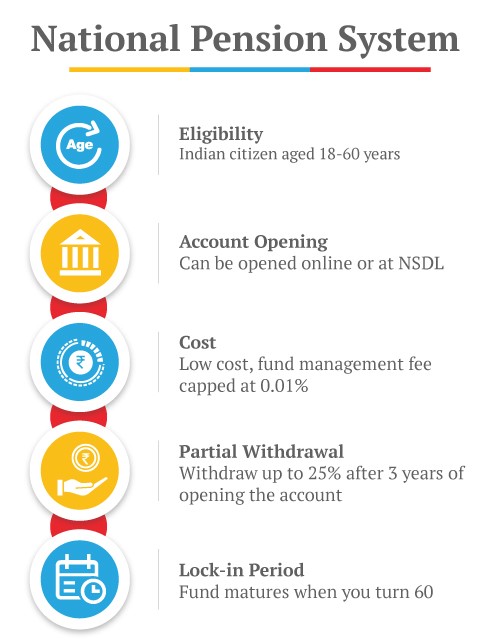The primary purpose of the National Pension System (NPS) was to offer a better return on investment for long-term retirement funds. You can receive a return on NPS depending on the quantum of contribution. The government pension scheme, in the earlier avatar, was restricted to people working for government departments or public sector undertakings. The amount of pension was defined as 50% of the last drawn salary. The burden of funding the gap in pension fund availability and needs would become a part of the government’s annual budget.
NPS has taken this burden off the government's shoulders and opened the opportunity of saving for retirement to all Indian Citizens including NRIs. Thus, you can now benefit from the country’s economic growth over the decades until your retirement. NPS also lets you invest in the relative safety of fixed-income government securities if you want to avoid equity market risks.
Historical Returns on NPS
The return on investment in NPS depends on the fund’s performance. A scheme’s market performance is a strong indicator of the average return possible from NPS. The earlier you start investing; the higher the chance of building a bigger retirement corpus.
| Scheme | 1-YEAR | 5-YEARS | 10-YEARS |
|---|---|---|---|
| E | 1.65% | 10.24% | 12.83% |
| C | 2.82% | 7.24% | 9.12% |
| G | 1.56% | 6.81% | 8.63% |
| A | 8.61% | 7.92% | NA |
* CAGR based on historical data provided by NPS Trust as on 11 Aug 2022
You must stay invested for the long run if you want inflation-beating returns. Investing in equity will help you generate wealth faster.
The new NPS opened up the opportunity of earning pensions to everyone irrespective of their profession and employment. The scheme now focused on contribution instead of fixating on outcome. This change meant that the cap on earning pension was now removed. The amount you would receive as a pension post retirement solely depended on the money you invested.
The returns from NPS depend on the performance of your funds in the market. However, you may choose the allocation depending on your risk appetite.
- Scheme E (equity) allows up to 75% allocation to equity
- Scheme C (corporate debt) which invests up to 100% in corporate bonds
- Scheme G (government/gilt bonds) focuses only on government bonds and allows up to 100% allocation
- Scheme A (alternative investment) permits up to 5% allocation
Understand the NPS Schemes
You may like to know the intricacies of various NPS schemes before selecting one for investing your money. This choice is for you to decide the asset class allocation and choose the ratio in which your contributions would be invested among various asset classes.
However, there are limitations because the maximum permitted allocation to equities is restricted to 75%. Each Pension fund manager has a bouquet of fund schemes that you may select from.
1. Corporate CG Scheme:
For corporates investing in pension funds, PFRDA has launched a new scheme called the corporate central government scheme (Corporate-CG scheme). The new scheme brings parity in fund management charges.
Companies can invest in NPS by choosing either the private sector NPS or government NPS. Both the saving schemes are similar in architecture but differ in investment patterns.
2. Scheme A-Tier 1:
Alternative investments such as Commercial Mortgage-Backed Securities, Real Estate Investment Trusts, Infrastructure Investment Trusts, venture capital funds etc fall under this scheme.
3. Scheme E-Tier 1:
Investments primarily in equity market instruments. The maximum permissible investment is 50% of the total contribution
4. Scheme C-Tier 1:
Corporate debt and related instruments. This allows investment of up to 100% in corporate bonds.
5. Scheme G-Tier 1:
Scheme G - TIER I is an NPS scheme that invests predominantly in government Securities and "low risk, low return" fixed income instruments.
Investment Choices for NPS
The first is a standard auto-invest option and is useful if you find it difficult to decide on your investments. The second is an active choice option if you want to plan your investments yourself.
a. Active Choice:
In active choice, you can design your financial portfolio and allocate funds from the available four asset classes. You may decide how much to invest, and select the pension fund manager (PFM), scheme as well as percentage allocation to be done.
b. Auto Choice:
If financial portfolio management is not something you know or are interested in, NPS gives you the flexibility to opt for a dynamic and automatic allocation of your money.
Your money will be invested in asset classes in specific proportions basis your age. As you age, exposure to equity and corporate debt gradually diminishes while increasing in government securities.
Benefits of NPS Investment
If you are exploring investments to save on tax, the National Pension Scheme (NPS) is a good avenue. Besides tax benefit, NPS also aids in growing your wealth and building a retirement kitty. Some of the other benefits associated with NPS:
a) You are free to choose where to invest
b) Qualified and reputed pension fund managers (PFMs) manage your money
c) You may fix/define your monthly contributions
d) Manage your account from anywhere
e) Your employer(s) can contribute to your NPS account
f) You can increase regular investments as your income grows
g) Maximum tax benefit of up to Rs 2 lakhs
h) Enjoy market-linked growth for your portfolio over a few decades
i) Disciplined withdrawals as the account stays locked in until you reach 60 years of age
j) You can withdraw in emergencies and for important life goals like a child’s higher education or home purchase
Click here - NPS Withdrawal
What is the Alternative to NPS?
Although, with its features well suited for retirement goals, NPS has few rivals. Unit Linked Insurance Plans or ULIPs from life insurers can compare neck to neck when it comes to long-term investments. Online ULIP plans like Invest 4G from Canara HSBC Life Insurance offer features and benefits well-suited for your retirement goals:
- Tax-free partial withdrawals after five years of investment
- A total annual investment of up to Rs 2.5 lakhs offers tax-free growth
- Life cover adds to your family’s financial safety
- Invest up to 99 years of age, i.e., build corpus until 60-65 years and then withdraw tax-free pension till 99
- Invest in a mix of diversified equity and debt portfolios
- Automatically manage the portfolio with given strategies
- Free bonus additions for long-term investors
NPS should be one of the several investment assets that you should invest your money in. Diversification is critical for reaching long-term financial goals with minimal risk. Diversification reduces risk by allocating funds across different financial instruments, and investment classes.
Adding investments like ULIP provides you with adequate diversification while maintaining long-term growth. A diversified portfolio opens up more opportunities, reduces stress, and gives sustainable returns.
Disclaimer: This article is issued in the general public interest and meant for general information purposes only. Readers are advised to exercise their caution and not to rely on the contents of the article as conclusive in nature. Readers should research further or consult an expert in this regard.
Retirement - Top Selling Plans
We bring you a collection of popular Canara HSBC life insurance plans. Forget the dusty brochures and endless offline visits! Dive into the features of our top-selling online insurance plans and buy the one that meets your goals and requirements. You and your wallet will be thankful in the future as we brighten up your financial future with these plans.
Fixed Returns, Zero Risks & Worries
- 4 Plan options
- Life cover + Guaranteed benefits
- Accidental death benefit
- Premium protection cover
Retire Grand with Flexi Benefits
- Guaranteed Lifelong Income
- Limited premium payment term
- Multiple annuity options
- Option to defer the annuity payments
Save, Dream, Plan. Live Peacefully
- 4 Plan options
- Option to choose premium payment term
- Get Tax benefits
- Premium protection cover
Recent Blogs





Popular Searches
- Retirement Calculator
- Best Retirement Plan
- Senior Citizen Card
- Saral Pension Plan
- NPS Withdrawal
- Pension4Life Plan
- Retirement Planning
- 5 Retirement Tips
- National Pension Scheme
- NPS Pension Calculator
- Types of Pension Plan
- Guaranteed Pension Plan
- Is Pension Taxable
- How to Check Old Age Pension Status
- Benefits of Pension Plan

